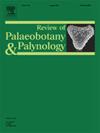A new species of Stutzeliastrobus (Cupressaceae) from the Early Cretaceous of the Guyang Basin, northern China, and its paleoenvironmental implications
IF 1.7
3区 地球科学
Q2 PALEONTOLOGY
引用次数: 0
Abstract
A cupressaceous conifer, Stutzeliastrobus araucarioides comb. nov. is described from the Lower Cretaceous Guyang Formation in the Guyang Basin, central Inner Mongolia, northern China. Stutzeliastrobus araucarioides is known based on well-preserved leafy shoots with attached ovuliferous cones, and is characterized by elongate ovuliferous cones with numerous helically arranged, flat cone-scale complexes. Each complex is composed of a fused bract and ovuliferous scale and bears two seeds on the proximal to middle region. Stutzeliastrobus araucarioides is most similar in gross morphology to extant Taiwania cryptomerioides, but differs by having many more bract-scale complexes per cone. The features of S. araucarioides confirm that Stutzeliastrobus is closely relared to Taiwania. The new material enriches the fossil record of Stutzeliastrobus and adds to knowledge of the diversity of early Cupressaceae from the Early Cretaceous. Associated fossils and sedimentary facies indicate that S. araucarioides occupied lacustrine-paludal environments that hosted a diverse range of conifers and ginkgoaleans.
固阳盆地早白垩世一新种(柏科)及其古环境意义
一种柏科针叶树;11 .来自中国北部内蒙古中部固阳盆地下白垩统固阳组。Stutzeliastrobus araucarioides是基于保存完好的叶状芽和附着的胚珠状球果而为人所知的,其特征是细长的胚珠状球果和许多螺旋排列的扁平锥体。每个复合体由融合的苞片和胚珠鳞片组成,在近端到中部区域上有两个种子。Stutzeliastrobus araucarioides在大体形态上与现存的台湾隐叶菊最相似,但不同之处是每球果有更多的苞片尺度复合体。该株的特征证实了Stutzeliastrobus与台湾的亲缘关系。新材料丰富了Stutzeliastrobus的化石记录,增加了对早白垩纪早期柏科多样性的认识。相关化石和沉积相表明,S. araucarioides位于湖泊-古带环境中,生长着多种针叶树和银杏树。
本文章由计算机程序翻译,如有差异,请以英文原文为准。
求助全文
约1分钟内获得全文
求助全文
来源期刊
CiteScore
3.50
自引率
21.10%
发文量
149
审稿时长
6 months
期刊介绍:
The Review of Palaeobotany and Palynology is an international journal for articles in all fields of palaeobotany and palynology dealing with all groups, ranging from marine palynomorphs to higher land plants. Original contributions and comprehensive review papers should appeal to an international audience. Typical topics include but are not restricted to systematics, evolution, palaeobiology, palaeoecology, biostratigraphy, biochronology, palaeoclimatology, paleogeography, taphonomy, palaeoenvironmental reconstructions, vegetation history, and practical applications of palaeobotany and palynology, e.g. in coal and petroleum geology and archaeology. The journal especially encourages the publication of articles in which palaeobotany and palynology are applied for solving fundamental geological and biological problems as well as innovative and interdisciplinary approaches.

 求助内容:
求助内容: 应助结果提醒方式:
应助结果提醒方式:


